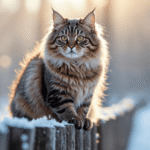The genes responsible for the tortoiseshell and calico patterns lie on the X chromosome. It controls the coloration in these cats. Since female cats are XX, they have the possibility of having two colors. Male cats that have the typical chromosome arrangement of XY cannot have it except in rare cases of Klinefelter syndrome. All of this leads to the existence of some XXY male torties or calicos, but they are few and are mostly infertile. Since this genetic disposition is a bit more common in females, colors in males with this genotype make them biologically a rare breed and a genetic spectacle. In this article, we are going to discuss the comparison between Tortie vs Calico.
Personality Traits: Tortie vs. Calico
One of the intriguing things about torties and calicos is their self-reported personalities from previous owners. Owners often use the term “tortitude” to describe some of the torties which refers to their more self-assertive nature. Calicos are very attractive cats for children, who tend to be more playful, social, and warm, which very much seems to be the case in most families. Of course, these are all stereotypes, and certainly, most of the time enthusing calicos is not unexpected whereas torties may be more reserved or slightly more loyal to one person.
Cultural Significance and Special Symbol
The breed of torties and calicos is marked with plenty of folklore. Throughout history, these have also been regarded as good omen. In the US, people think that money cats or calico cats bring wealth. While in Japan, the calico Maneki Neko figurine is respected as a talisman. Tortoiseshell cats, on the other hand, belong to the Celtic category. People consider it a sign of good luck as they ward away evils from the house. People are thinking that different color patterns have different meanings also adding to the mystique and the cultural essence of these cats.
Health and Life Expectancy
Life expectancy for torties and calicos is comparable, at about 12-16 years. For the majority, the color pattern does not exist which may make them fall sick. However, in single out the case of male calicos or torties, they have XXY chromosome structure which may cause certain health hazards such as metabolic and cardiac troubles. Other than this rare scenario in males, generally, torties and calicos enjoy long, healthy lifespans.
Exploring Tortoiseshell and Calico Cats

There is a close genetic relationship. It determines the colors of tortoiseshell and calico cats explaining the reasons why these patterns are predominantly female. In turn, let’s go further and examine how this appearance is genetically conditioned, what myths exist about these patterns, and how these cats fit into reality.
Genetics: The Master Plan of Figured Colors
The genetic code for these coat types is based on the X chromosome. All female cats have two X chromosomes (XX). It allows them to have color patterns transforming a cat into a tortoiseshell or a calico. The majority of male cats have an X chromosome plus a Y chromosome (XY), so they typically do not. There are occasions when, though, a male cat will have an extra X chromosome. It makes him XXY instead of XY. This type of genetic defect resembles Klinefelter syndrome which is observed in human males. What this defect does, in most cases, is produce a color pattern of calico, or tortie, in a male cat who is sterile because of genetic issues.
Torties vs Calicos show two forms of alleles one with orange coloration and the other with black pigmentation. Tortoiseshell cats show these colors, which are also devoid or have only small white spots, in a broken or blended form. But calico cats get a “spotting gene”. It allows them to have considerable amounts of white in between the black and orange. They are the colors of this specific breed in combination with grey and cream, which gives them a tri-colored appearance .
Appearance and Different Patterns of Coat
In common, you can find tortoiseshell cats in two colors. These colors are black and orange. They are in marble or brindle in color. Very few may have pale tan or cream highlights but do not possess the white color. On the other hand, calico cats have different colors like bicolor or tricolor, and include quite large and distinct patches of white coat. It gives them black and orange or other patterns of light blue and brown more organized in the color scheme.
Some tortoiseshell cats seem to be white although most would be covered by the classification of being both “torticos” or in the tune of partial tortoiseshell calico cross rather than pure calico. The distribution of all the different genes also calls for an allowance for diverse coat patterns such as varying coat lengths and shapes. Some can grow short hair while in some breeds such as the Maine Coon or Persian, the hair may grow longer giving room for tortoiseshell or calico patterns to pass as well .
Health Implications of XXY in Male Gender
Men with the XXY genetic configuration are more likely to develop diabetes and heart disease when compared to healthy males. Even though the calico or tortie coloration itself doesn’t make them susceptible to some distinct health issues. The atypical XXY genetics can render them vulnerable to some metabolic or cardiovascular diseases like the Klinefelter syndrome in human cases. Female cat torties and calicos, besides their coat patterns, don’t have health problems. They are specific to certain breeds and live up to the age of 15 years. It is the average age of a normal cat.
Comparison Table: Tortie vs. Calico Cats
| Feature | Tortoiseshell (Tortie) | Calico |
| Color Pattern | Black and orange blend, minimal/no white | White, black, and orange (distinct patches) |
| Genetics | Requires two X chromosomes | Requires two X chromosomes |
| Gender | Predominantly female; rare male (XXY) | Predominantly female; rare male (XXY) |
| Personality Traits | “Fortitude”: independent, feisty | Friendly, adaptable, social |
| Cultural Symbolism | Good luck in Celtic folklore | Money cat in the U.S., lucky in Japan |
| Health | No unique health risks in females | XXY males prone to metabolic conditions |
| Average Lifespan | 12-16 years | 12-16 years |
Breeds and Coat Length
Although tortoiseshell and calico patterns are color patterns, not breeds, they are popular among several cat breeds. American Shorthair, British Shorthair, Maine Coon, Persian, and Japanese Bobtail are some of the breeds. It can display these patterns. Long-haired varieties such as the Maine Coon or Persian also stand out with their calico or tortie coats which are also quite lustrous.
Conclusion
Tortie vs Calico patterns are exceptional examples of how much genetic diversity is present in domestic cats. Since their looks are genetically determined, it presents an interesting range of colors that pleases cat fanciers out there. These two breeds are different. With different superstitions from being a good luck charm and protective figures to even being about the fierce “fortitude” that they possess. Be it the single-mindedness of a tortie or the friendly manners of a calico, these cats enliven any household with their beauty and charm. Given the circumstances that even the designs and histories are different, torties and calicos are still some of the most popular breeds in the cat aficionados circle.
FAQs
It is due to an additional X chromosome resulting in an XXY genetic variation. It causes male calicos and torties to occur. This deficiency exists because there is a need for two X chromosomes for these color patterns which is uncommon in males.
No, tortoiseshell and calico are a color pattern, not a specific breed of cat. There are several breeds; that can have these color patterns.
Torties exude a ” fortitude”, they are fiercely independent and assertive. While calicos on the other hand tend to be more sociable and easier to adapt to fitting well within a family setting.





